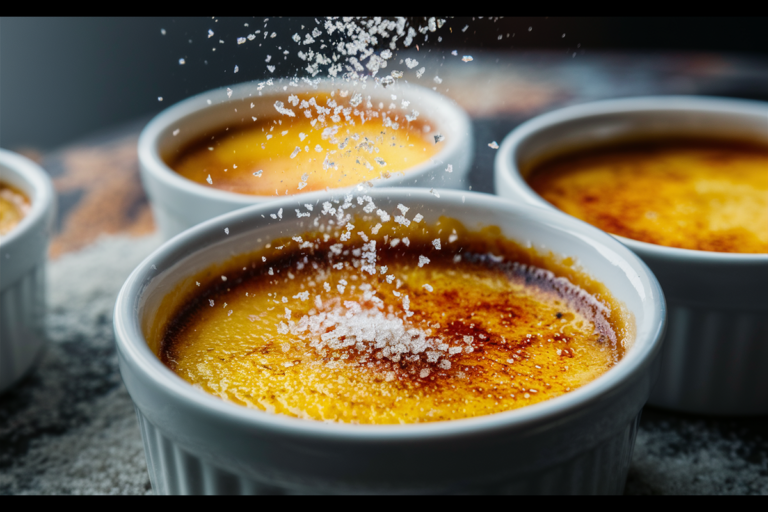Crème brûlée is a dessert that epitomizes both elegance and indulgence. With its velvety custard base topped by a crisp, caramelized sugar crust, it’s a treat that many aspire to perfect. But how do you achieve that quintessential caramelized top? In this comprehensive guide, we’ll walk you through the step-by-step process of how to caramelize brûlée so that you can enjoy that iconic crack when you dig your spoon into it.
What is Crème Brûlée?
Crème brûlée is a classic French dessert that literally translates to “burnt cream.” Renowned for its simple yet luxurious combination of flavors and textures, it has a rich history dating back to the 17th century. Although primarily associated with French cuisine, some believe it may have roots in England or Spain.
For more in-depth tips on mastering this dessert, check out our Secret to Crème Brûlée article, which delves into techniques for achieving the perfect custard every time.
Components of Crème Brûlée:
- Custard Base: A creamy, smooth custard made from egg yolks, sugar, and cream, often infused with vanilla.
- Caramelized Sugar Top: A brittle, glass-like crust created by caramelizing sugar just before serving.
The perfect crème brûlée hinges on striking the right balance between the cool, creamy custard and the hot, crispy caramelized top. The process of caramelizing the sugar not only adds texture but also imparts a deep, toasty flavor that contrasts beautifully with the sweet custard beneath.
For those interested in the history and variations of this classic dessert, explore this comprehensive guide on French desserts.
The Science Behind Caramelization
Understanding the science behind caramelization is key to mastering how to caramelize brûlée effectively. Caramelization is a complex chemical process that occurs when you heat sugar to a specific temperature, typically between 320°F (160°C) and 356°F (180°C).
Key Points in Caramelization caramelize brûlée:
- Temperature: Sugar begins to melt and caramelize at around 320°F (160°C). At this point, the sugar molecules break down, leading to a change in flavor and color.
- Caramelization vs. Maillard Reaction: Unlike the Maillard reaction, which involves amino acids and reducing sugars, caramelization is purely the result of heating sugars. This process gives the brûlée its characteristic deep amber color and complex flavor profile.
- Flavor Development: As the sugar caramelizes, it transitions from sweet to slightly bitter, adding layers of flavor that complement the sweetness of the custard.
For a deeper dive into the science of caramelization, you might enjoy reading about caramelization and the Maillard reaction.
Tools and Equipment Needed for Caramelizing Brûlée
Achieving that perfect caramelized top requires the right tools. Here’s what you should have on hand:
Essential Tools:
- Kitchen Torch: The most common tool for caramelizing brûlée. It allows for precise control over the caramelization process, ensuring an even, crackling crust.
- Broiler: An alternative to the torch, a broiler can also do the job, although it requires careful monitoring to prevent uneven cooking.
- Heatproof Dishes (Ramekins): Essential for holding the custard while you caramelize the sugar.
Optional Tools:
- Fine-Mesh Sieve: Helps to evenly distribute sugar over the custard surface.
- Infrared Thermometer: Useful for those who want to monitor the exact temperature of the caramelized sugar.
When choosing a kitchen torch, consider brands like Iwatani and Bernzomatic for their durability and ease of use.
Step-by-Step Guide to Caramelizing Brûlée
Mastering how to caramelize brûlée is all about technique. Follow these steps to ensure success:
Prepare the Custard Base
Ingredients caramelize brûlée :
- 6 large egg yolks
- 1/2 cup granulated sugar
- 2 cups heavy cream
- 1 vanilla bean (or 1 teaspoon vanilla extract)
If you’re looking for a dessert that’s a bit lighter but equally delicious, you might also enjoy our Zesty Lemon Pepper Cod with Fresh Herbs recipe, which offers a refreshing contrast to the richness of crème brûlée.
Preparation Tips:
- Whisk the Egg Yolks and Sugar: In a bowl, whisk the egg yolks and sugar until pale and slightly thickened.
- Heat the Cream: In a saucepan, heat the cream and vanilla until just simmering.
- Temper the Eggs: Slowly add the hot cream to the egg mixture, whisking constantly to temper the eggs without curdling them.
- Bake: Pour the mixture into ramekins and bake in a water bath at 325°F (160°C) for about 30-35 minutes, or until the custard is set but still slightly jiggly in the center.
- Chill: After baking, allow the custard to chill in the refrigerator for at least 4 hours, preferably overnight, to ensure it’s fully set.
Preparing the Sugar Topping
Choosing the Sugar:
- White Granulated Sugar: Works best for caramelizing. For a richer flavor, you might experiment with turbinado or demerara sugar.
Even Distribution:
- Sprinkle Sugar: Use a fine-mesh sieve or your hands to sprinkle an even layer of sugar (about 1-2 teaspoons per ramekin) over the chilled custard.
Caramelizing the Sugar
Using a Kitchen Torch:
- Hold the torch about 2-3 inches above the sugar surface.
- Move the flame in a circular motion to evenly melt and caramelize the sugar.
- Watch for color changes, aiming for a deep amber without burning the sugar.
Using a Broiler:
- Preheat the broiler on high.
- Place the ramekins on a baking sheet and broil them about 2 inches from the heat source.
- Rotate the baking sheet for even caramelization, watching closely to prevent burning.
Cooling and Serving
- Allow the Caramel to Harden: Let the brûlée sit for a few minutes after caramelizing to allow the sugar to harden into a crisp shell.
- Serving Tips: Serve immediately to enjoy the contrast between the warm, crisp sugar and the cold custard.
Common Mistakes and How to Avoid Them
Caramelizing sugar can be tricky, but knowing common pitfalls helps you avoid them:
- Overcooking the Sugar: This leads to a bitter, burnt taste. Keep a close eye on the sugar as it caramelizes to avoid this issue.
- Undercooking the Sugar: Results in a soggy topping that won’t crack properly. Make sure the sugar is fully melted and caramelized.
- Uneven Caramelization: Can happen if you hold the flame too close or if the broiler heat is uneven. Keep the torch or baking sheet constantly moving for even coverage.
- Custard Melting: If the custard warms too much during caramelization, it loses its firm texture. Keep the flame moving and avoid prolonged exposure to heat.
Variations and Creative Twists on Traditional Crème Brûlée
While the classic crème brûlée is always a crowd-pleaser, experimenting with different flavors and toppings can elevate this dessert:
- Flavored Sugars: Infuse sugar with vanilla beans, cinnamon, or citrus zest for a subtle twist.
- Infused Custards: Incorporate flavors like chocolate, coffee, or fruit purees into the custard base for a unique taste.
- Alternative Toppings: Instead of sugar, try caramelizing fruits like bananas or using nuts for added texture.
- Dietary Alternatives: Make a vegan version using coconut milk and a plant-based thickener, or a low-sugar option with stevia or erythritol.
For more inspiration on flavor combinations, check out this guide to creative brûlée variations.
Health and Nutritional Insights
Crème brûlée is undeniably rich, but there are ways to enjoy it while keeping an eye on your diet:
Nutritional Breakdown:
- A traditional serving of crème brûlée can range from 200-300 calories, with high amounts of fat and sugar.
Healthier Alternatives:
- Substitutes: Use a mix of milk and half-and-half instead of heavy cream, reduce the sugar in the custard, or use a natural sweetener like stevia.
- Moderation: Enjoy crème brûlée as an occasional treat within a balanced diet.
Storing and Reheating Crème Brûlée
If you have leftovers or want to prepare ahead of time, proper storage is crucial:
- Storing: Cover the custard (before caramelizing) with plastic wrap and refrigerate for up to 3 days.
- Re-caramelizing: Add fresh sugar and caramelize just before serving to maintain the crisp topping.
- Shelf Life: While the custard can be made ahead, it’s best to enjoy crème brûlée within 24 hours of caramelizing for optimal texture and flavor.
Pairings and Serving Suggestions
To enhance the experience of your crème brûlée, consider these pairings:
- Wine Pairings: Sweet wines like Sauternes or a late harvest Riesling complement the richness of crème brûlée perfectly.
- Coffee or Tea: A strong espresso or a delicate jasmine tea can balance the dessert’s sweetness.
- Accompaniments: Fresh berries, a dollop of whipped cream, or a biscotti add contrast and texture to the dessert.
FAQs
Why is my crème brûlée not caramelizing properly? This issue often arises due to using the wrong type of sugar or not applying enough heat. Ensure you’re using fine granulated sugar and either a high-quality kitchen torch or a broiler set to high. Also, make sure the custard is thoroughly chilled before caramelizing to prevent the sugar from melting into the custard.
Can I caramelize crème brûlée without a torch? Yes, you can use a broiler as an alternative method. Place the ramekins under a preheated broiler and watch closely to prevent burning. Rotate the ramekins if necessary to ensure even caramelization.
How thick should the sugar layer be? The sugar layer should be about 1/8 inch thick, enough to cover the custard completely without being too thick, which can lead to uneven caramelization. If the layer is too thin, you might not achieve that satisfying crack.
What sugar works best for caramelizing? White granulated sugar is ideal due to its fine crystals, which melt evenly. Brown sugar can be used for a deeper flavor, but it may caramelize faster and require more careful monitoring to prevent burning.
Why did my custard curdle during the cooking process? Curdling usually occurs if the custard mixture is overheated. To prevent this, temper the eggs slowly by adding the hot cream gradually while whisking constantly. Bake the custard in a water bath at a low temperature, ensuring that it cooks gently and evenly.
Conclusion
Mastering how to caramelize brûlée opens up a world of possibilities for impressing guests or indulging in a luxurious treat at home. By understanding the science behind caramelization, using the right tools, and following a careful process, you can achieve that perfect, crackling sugar top every time. Don’t be afraid to experiment with flavors and techniques to make this classic dessert your own. Remember, practice makes perfect, so keep trying until you get it just right.
Feel free to share your experiences, tips, or any questions in the comments below. Happy cooking!

